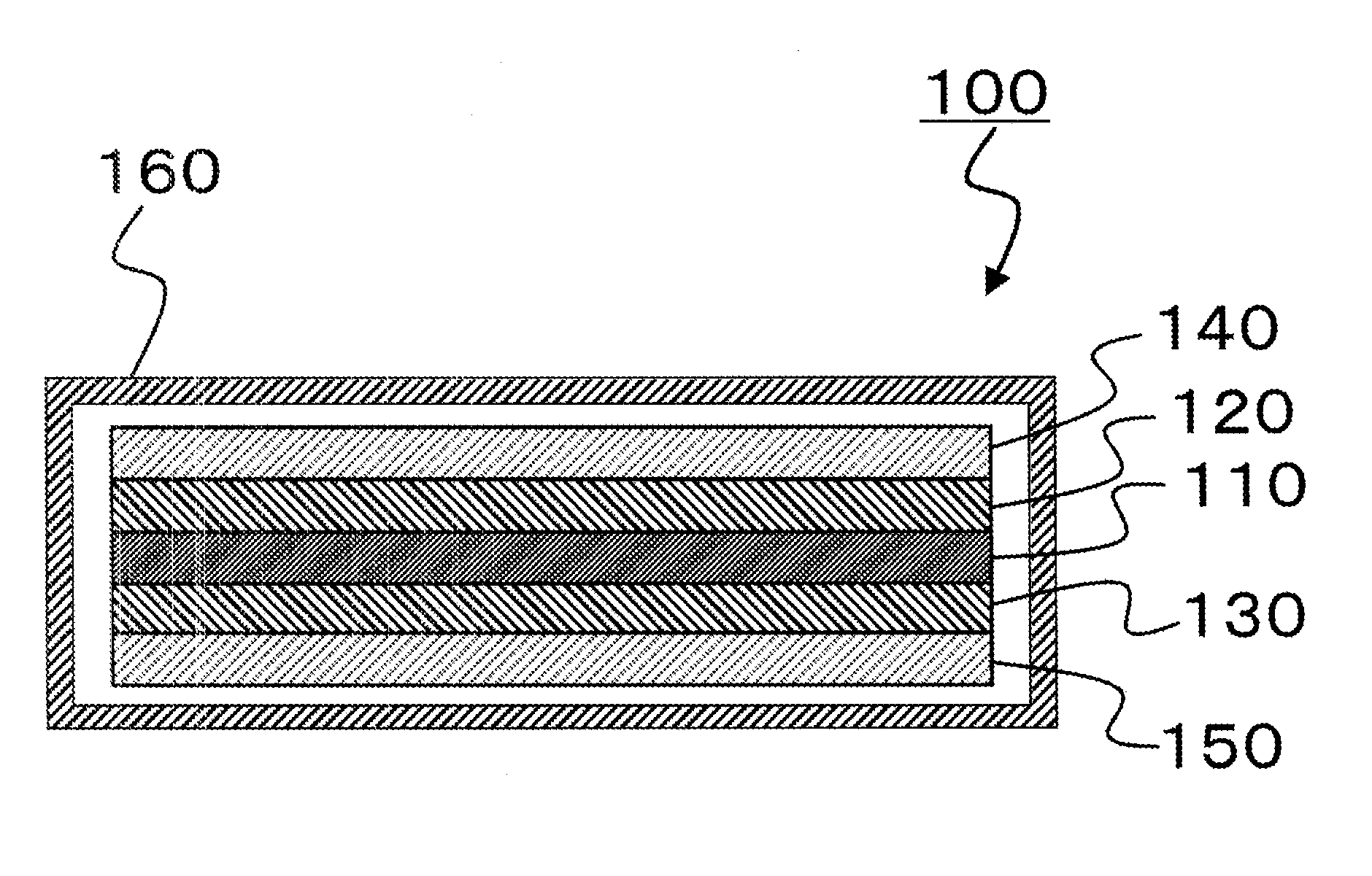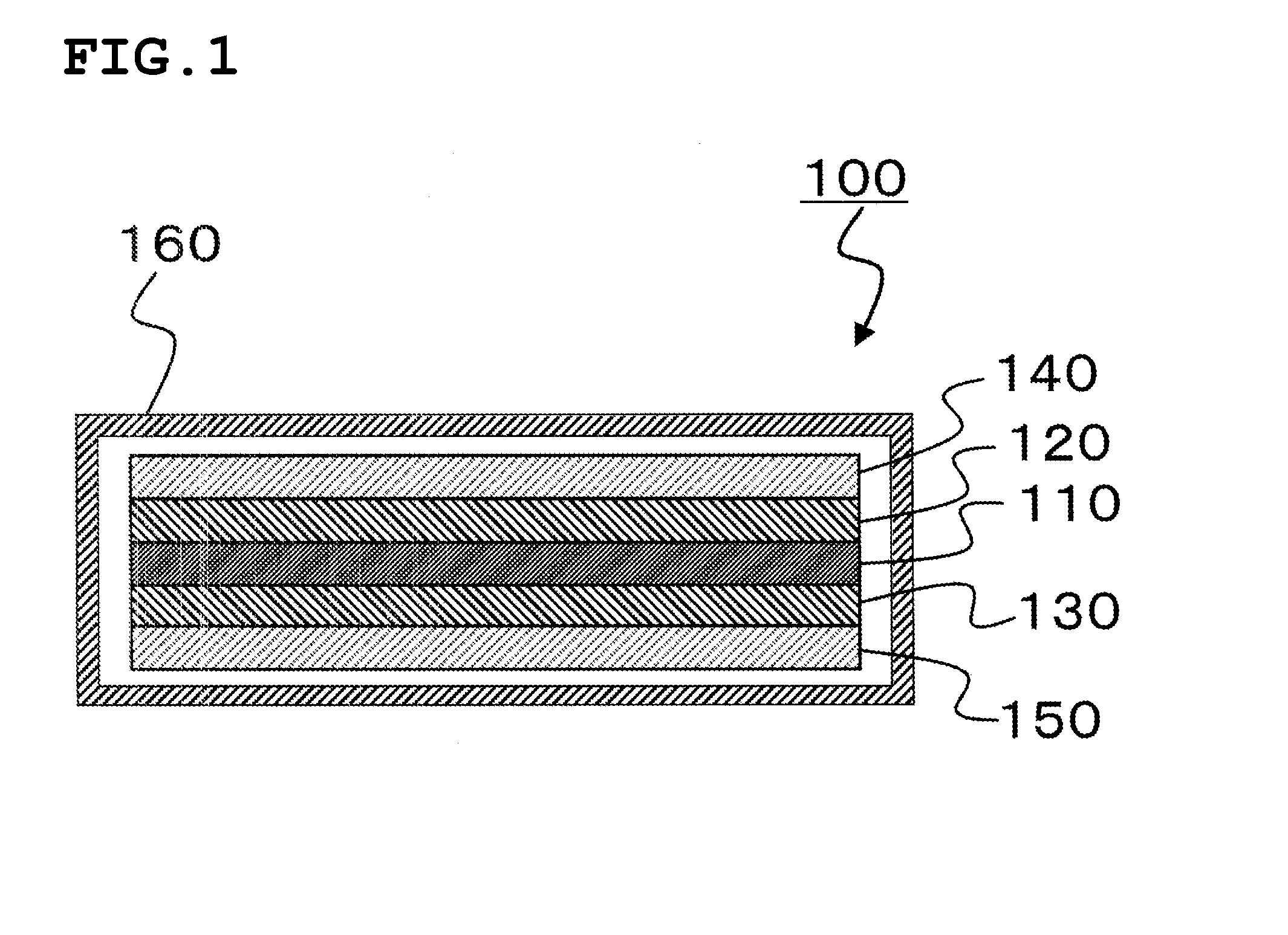Electrolytic solution for non-aqueous energy storage device and lithium ion secondary battery
a technology of non-aqueous energy storage and electrolysis solution, which is applied in the direction of non-aqueous electrolyte cells, cell components, electrochemical generators, etc., can solve the problems of reducing the cycle life of batteries, and achieve the effects of high voltage, less gas generation, and high cycle li
- Summary
- Abstract
- Description
- Claims
- Application Information
AI Technical Summary
Benefits of technology
Problems solved by technology
Method used
Image
Examples
example 1
[0168]0.05 g of lithium bis(oxalato)borate represented by formula (11) (made by Rockwood Lithium GmbH, hereinafter written as “LiBOB”) and 0.05 g of tris(trimethylsilyl)phosphate (PO4(Si (CH3)3)3, made by Sigma-Aldrich Corporation, 275794) were added to 9.85 g of a solution (made by KISHIDA CHEMICAL Co., Ltd., LBG00069) comprising a mixed solvent of ethylene carbonate and ethylmethyl carbonate in a volume ratio of 1:2 and 1 mol / L of LiPF6 salt. Thus, an electrolytic solution A was prepared. The content of LiBOB in the electrolytic solution A was 0.5% by mass, the content of tris(trimethylsilyl) phosphate was 0.5% by mass, and the content of LiPF6 was 13% by mass.
[0169]A lithium ion secondary battery was produced by the method described in (1) above using the electrolytic solution A, and the battery performance was evaluated. The lithium ion secondary battery containing the electrolytic solution A had a high discharge capacity at the first cycle of 118 mAh / g, and a high discharge cap...
example 2
[0171]0.05 g of LiBOB and 0.1 g of tris(trimethylsilyl)phosphate were added to 9.85 g of a solution comprising a mixed solvent of ethylene carbonate and ethylmethyl carbonate in a volume ratio of 1:2 and 1 mol / L of LiPF6 salt to obtain an electrolytic solution B. The content of LiBOB in the electrolytic solution B was 0.5% by mass, the content of tris(trimethylsilyl)phosphate was 1.0% by mass, and the content of LiPF6 was 13% by mass.
[0172]The battery performance of the lithium ion secondary battery containing the electrolytic solution B was evaluated in the same manner as in Example 1 by the method described in (1) above. As a result, the battery had a high discharge capacity at the first cycle of 117 mAh / g, a high discharge capacity at the 30th cycle of 93 mAh / g, and a high discharge capacity retention rate of 79%. The discharge capacity retention rate was obtained by dividing the discharge capacity at the 30th cycle by the discharge capacity at the first cycle.
[0173]The gas gener...
example 3
[0174]0.05 g of LiBOB and 0.2 g of tris(trimethylsilyl)phosphate were added to 9.75 g of a solution comprising a mixed solvent of ethylene carbonate and ethylmethyl carbonate in a volume ratio of 1:2 and 1 mol / L of LiPF6 salt to obtain an electrolytic solution C. The content of LiBOB in the electrolytic solution C was 0.5% by mass, the content of tris(trimethylsilyl)phosphate was 2.0% by mass, and the content of LiPF6 was 13% by mass.
[0175]The battery performance of the lithium ion secondary battery containing the electrolytic solution C was evaluated in the same manner as in Example 1 by the method described in (1) above. As a result, the battery had a high discharge capacity at the first cycle of 117 mAh / g, a high discharge capacity at the 30th cycle of 95 mAh / g, and a high discharge capacity retention rate of 81%. The discharge capacity retention rate was obtained by dividing the discharge capacity at the 30th cycle by the discharge capacity at the first cycle.
[0176]The gas gener...
PUM
| Property | Measurement | Unit |
|---|---|---|
| voltage | aaaaa | aaaaa |
| energy consumption | aaaaa | aaaaa |
| oxidation resistance | aaaaa | aaaaa |
Abstract
Description
Claims
Application Information
 Login to View More
Login to View More - R&D
- Intellectual Property
- Life Sciences
- Materials
- Tech Scout
- Unparalleled Data Quality
- Higher Quality Content
- 60% Fewer Hallucinations
Browse by: Latest US Patents, China's latest patents, Technical Efficacy Thesaurus, Application Domain, Technology Topic, Popular Technical Reports.
© 2025 PatSnap. All rights reserved.Legal|Privacy policy|Modern Slavery Act Transparency Statement|Sitemap|About US| Contact US: help@patsnap.com



